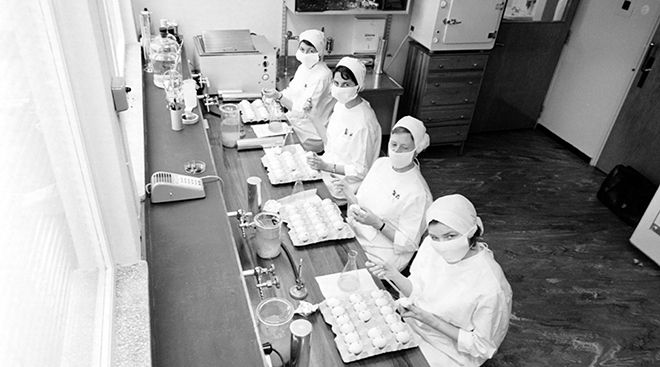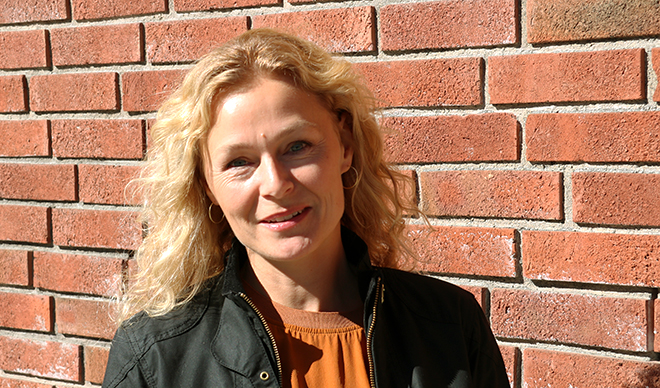The Norwegian welfare institution is not as Norwegian as many people think.

The Norwegian Institute of Public Health (Folkehelseinstituttet, FHI) was established when the government wanted to increase it's capacity to develop vaccines. Here are four women working at the FHI influenza laboratory in 1962. Photo: Unknown/Workers archive and library.
Photo: Ukjent/Arbeidernes arkiv og bibliotek.
March 12th 2020: Norway shuts down to halt the spread of Covid-19. The decision is made in close consultation with the country's foremost health authorities: The Norwegian Directorate of Health (Helsedirektoratet) and the Norwegian Institute of Public Health (Folkehelseinstituttet).
The fact that the health of the population is the responsibility of government is taken for granted in the Norwegian welfare state. But it hasn't always been that way.
"Before building up the welfare state in Norway, we received financial support from the United States for public health work. So what is often assumed to be a Nordic phenomenon - governmental responsibility for public health - is actually partly American", Sunniva Engh says.
Engh is an associate professor of history who has recently investigated the link between an institution which is a cornerstone of Norwegian welfare: the Norwegian Institute of Public Health, and an American oil magnate. Without US assistance, Norwegian public health work would have looked different today, she thinks.
The need to improve public health
At the turn of the 20th century, syphilis, smallpox and tuberculosis were ravaging diseases. Welfare schemes and health care were sorely lacking.
"Many different actors contributed in the field of health: The Norwegian Women's Public Health Association (Norske Kvinners Sanitetsforening) and the Red Cross trained nurses, and the hospitals were sometimes privately operated", Engh says.
"There was a consensus in the Norwegian medical and health policy communities that the government's ability to develop vaccines for the population was insufficient". Laboratories had been established at Rikshospitalet (National hospital), but much more was needed.
Both medical and political professionals wanted an institute of public health with a larger capacity to produce vaccines and make them available, as well as to analyse food and drinking water and to train medical personnel. The area Geitmyrsveien, which at the time was in the rural periphery of Oslo, was designated as a suitable site for the institute.
"When the Norwegian parliament and the Ministry of Social Affairs gave the green light, the plot in Geitmyrsveien was purchased in 1920". Additional grants were also made, but suddenly, in 1921, there was a complete reversal and the allocated money could not be spent after all.
Harder economic times in Norway had resulted in cuts in health and social work and quashed the plans for a Norwegian institute of public health.

Oil magnate with an idealistic wish to boost international health
At the same time, Norwegian physicians have come into contact with international medical communities, and with the help of generous scholarships, they have travelled abroad to learn about the latest developments in the field. Funds come from one man in particular: John D. Rockefeller and his philanthropic institution, Rockefeller Foundation.
"Rockefeller had amassed a lot of money from oil extraction and oil trading. He was the richest man in the world at the time, and a philanthropist - a parallel to Bill and Melinda Gates today", Engh says.
He was deeply religious and wanted to give something back to society.
"In 1913, he established a charitable foundation and began medical work in the United States. They focused in particular on fighting diseases and problems in the southern states in the USA, and as the foundation became successful, they realised that this was something they could do internationally".
The foundation created its own international health division and collaborated extensively with the League of Nations, the forerunner of the UN. Soon the foundation became central in international health work.
"The League of Nations was a new entity and did not have much funding. Rockefeller did, however! At one point, their funding amounted to as much as 40 percent of the League of Nations' budget for medical work", Engh says.
The historian points out that a number of authors believe the Rockefeller Foundation was not only a participant, but a game changer in international health.
"They set the agenda, which they were able to do by virtue of a large network and great financial impact". Through the funding of the League of Nations' work, arrangements were initiated for training and exchange, permitting medical personnel to meet across borders.
Rockefeller was eager to professionalise and standardise medical expertise.
"They commissioned large study reports that had great impact. When the national experts met to exchange views, the Rockefeller Foundation had already done much of the thinking for them".






